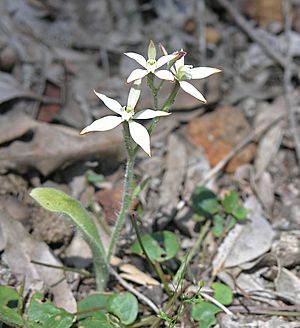White fairy orchid facts for kids
Quick facts for kids White fairy orchid |
|
|---|---|
 |
|
| Caladenia marginata at Jarrahdale, Western Australia | |
| Scientific classification | |
| Genus: |
Caladenia
|
| Species: |
marginata
|
| Synonyms | |
|
Caladeniastrum marginatum (Lindl.) Szlach. |
|
Caladenia marginata, also known as the white fairy orchid, is a special kind of orchid that only grows in the south-west part of Western Australia. It has one pale green, fuzzy leaf and can have up to four creamy-white flowers. These orchids often grow close together in big groups and bloom a lot after summer fires.
Contents
What the White Fairy Orchid Looks Like
The Caladenia marginata is a plant that grows from the ground, not on trees. It's a perennial plant, which means it lives for more than two years. It's also deciduous, so it loses its leaves at certain times. This plant is a herb and has a special underground tuber (like a small potato) that stores food. These orchids often grow in large, crowded groups.
Each plant has one wide, pale green leaf that feels a bit fuzzy. This leaf is usually 40–120 mm (2–5 in) long and about 15 mm (0.6 in) wide.
The orchid can have up to four creamy-white flowers, though sometimes they are pink. Each flower is about 2–30 mm (0.08–1 in) long and wide. These flowers grow on a stem that stands 80–200 mm (3–8 in) tall.
The back of the flower's sepals (which are like small leaves that protect the flower bud) and petals (the colorful parts of the flower) are a rusty-brown color. The top sepal, called the dorsal sepal, stands straight up. It's about 12–15 mm (0.5–0.6 in) long and 2–4 mm (0.08–0.2 in) wide. The side sepals, called lateral sepals, are 13–16 mm (0.5–0.6 in) long and 4–6 mm (0.16–0.24 in) wide, and they stick out stiffly.
The petals are 10–13 mm (0.4–0.5 in) long and 3–4 mm (0.1–0.2 in) wide, and they also spread out like the side sepals. The labellum (which is the orchid's special lip-like petal) is about 6.5–8 mm (0.26–0.31 in) long and wide. It has a few short teeth along its sides. In the middle of the labellum, there are two rows of yellowish bumps called calli.
White fairy orchids usually bloom from late September to November. They bloom the most after there has been a fire in the area the previous summer.
Even though they look a bit like the white or pink versions of pink fairies (C. latifolia), C. marginata flowers later in the year. Their flowers are also smaller and have brown hairs on the back, which helps tell them apart.
How the Orchid Got Its Name
The Caladenia marginata was first officially described in 1840 by a person named John Lindley. He wrote about it in a book called A Sketch of the Vegetation of the Swan River Colony.
The second part of its scientific name, marginata, comes from a Latin word. It means "having a border" or "furnished with a border." This name was chosen because the sepals and petals of this orchid have a thicker edge or border.
Where White Fairy Orchids Live
White fairy orchids grow in Western Australia. You can find them from Jurien Bay in the north-west all the way to Israelite Bay in the south-east.
They like to grow in wet areas like swamps and in thin soil on top of granite rocks. You can find them in several different natural areas, including the Avon Wheatbelt, Esperance Plains, Jarrah Forest, Mallee, Swan Coastal Plain, and Warren biogeographic regions.
Conservation Status
The Western Australian Government's Department of Parks and Wildlife has classified Caladenia marginata as "Not Threatened." This means that currently, there are enough of these orchids, and they are not considered to be in danger of disappearing.
See also
 In Spanish: Caladenia marginata para niños
In Spanish: Caladenia marginata para niños

